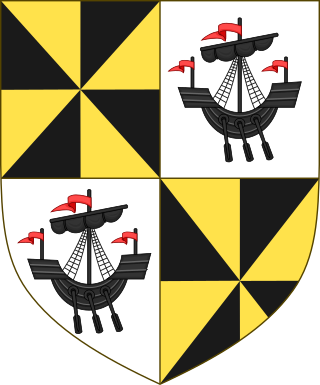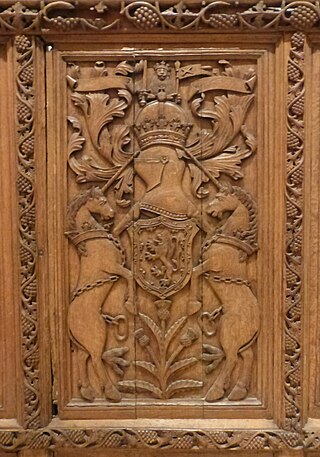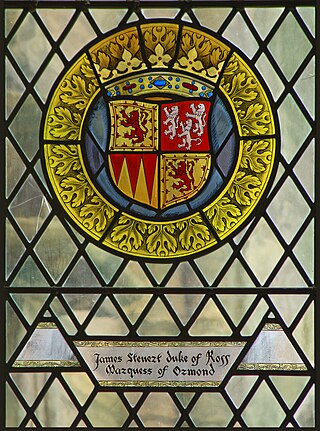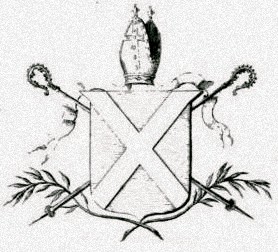Related Research Articles

Colin Campbell, 1st Earl of Argyll was a medieval Scottish nobleman, peer, and politician. He was the son of Archibald Campbell, Master of Campbell and Elizabeth Somerville, daughter of John Somerville, 3rd Lord Somerville. He had the sobriquet Colin Mulle, Bold Earl Colin.

The office of Lord Clerk Register is the oldest surviving Great Officer of State in Scotland, with origins in the 13th century. It historically had important functions in relation to the maintenance and care of the public records of Scotland. Today these duties are administered by the Keeper of the National Records of Scotland and the Keeper of the Registers of Scotland.

The office of Keeper of the Privy Seal of Scotland, one of the Great Officers of State, first appears in the reign of David II. After the Act of Union 1707 its holder was normally a peer, like the Keeper of the Great Seal. The office has remained unfilled since the death of Gavin Campbell, 1st Marquess of Breadalbane in 1922.

The Keeper of the Great Seal of Scotland, formerly known as Keeper of the Seal of the Kingdom of Scotland, is the keeper of the Great Seal of Scotland and one of the officers of the crown in Scotland. The Keeper of the Great Seal of Scotland is the incumbent First Minister of Scotland, currently Humza Yousaf.
John Lauder was Scotland's Public Accuser of Heretics. He was twice sent to Rome by King James V, to confirm the loyalty of the Scottish crown. As Principal Private Secretary to Cardinal David Beaton, Archbishop of St. Andrews, he successfully prosecuted many heretics, who were burnt at the stake, John Knox testifying to his extreme cruelty. Beaton was eventually murdered by the mob, but Lauder escaped and was later Private Secretary to Archbishop Hamilton.

James Stewart, Duke of Ross was a Scottish prince, and the second son of King James III of Scotland and his wife, Margaret of Denmark. James was heir presumptive to his brother until his death, and was Archbishop of St Andrews and Lord Chancellor of Scotland.
James Bane was Bishop of St. Andrews for a brief period in the early 14th century. In his earlier career, James had been a canon of Aberdeen and prebendary of Cruden.
Robert Blackadder was a medieval Scottish cleric, diplomat and politician, who was abbot of Melrose, bishop-elect of Aberdeen and bishop of Glasgow; when the last was elevated to archiepiscopal status in 1492, he became the first ever archbishop of Glasgow. Archbishop Robert Blackadder died on 28 July 1508, while en route to Jerusalem on pilgrimage.

The Chancellor of the University of St Andrews is the titular head of the University of St Andrews. Their duties include conferring degrees, promoting the university's image throughout the world, and furthering the university's interests worldwide. The Chancellor does have the power to refuse an "improvement in the internal arrangements of the University", however, there is no evidence of any Chancellor using this effective veto over the University Court.

The Prior, then Abbot and then Commendator of Dunfermline was the head of the Benedictine monastic community of Dunfermline Abbey, Fife, Scotland. The abbey itself was founded in 1128 by King David I of Scotland, but was of earlier origin. King Máel Coluim mac Donnchada had founded a church there with the help of Benedictines from Canterbury. Monks had been sent there in the reign of Étgar mac Maíl Choluim and Anselm had sent a letter requesting that Étgar's brother and successor King Alaxandair mac Maíl Coluim protect these monks. By 1120, when Alaxandair sent a delegation to Canterbury to secure Eadmer for the bishopric of St Andrews, there is a Prior of the Dunfermline monks by the name of Peter leading the delegation. Control of the abbey was secularized in the 16th century and after the accession of James Stewart in 1500, the abbey was held by commendators. In the second half of the 16th century, the abbey's lands were being carved up into lordships and it was finally annexed to the crown in July, 1593.
Holders of the office of Lord Chamberlain of Scotland are known from about 1124. It was ranked by King Malcolm as the third great Officer of State, called Camerarius Domini Regis, and had a salary of £200 per annum allotted to him. He anciently collected the revenues of the Crown, at least before Scotland had a Treasurer, of which office there is no vestige until the restoration of King James I when he disbursed the money necessary for the maintenance of the King's Household.
The Archdeacon of St Andrews was the head of the Archdeaconry of St Andrews, a sub-division of the Diocese of St Andrews, from the twelfth to the seventeenth century. The position was one of the most important positions within the medieval Scottish church; because of his area's large population and high number of parish churches, the Archdeacon of St Andrews may have exercised more power than many Scottish bishops. The following is a list of known archdeacons:
The Archdeacon of Dunkeld was the only archdeacon in the Diocese of Dunkeld, acting as a deputy of the Bishop of Dunkeld. The following is a list of archdeacons:
Donald Campbell was a 16th-century Scottish noble and churchman. He was the son of Archibald Campbell, 2nd Earl of Argyll and Elizabeth Stewart, daughter of John Stewart, 1st Earl of Lennox. From 1522, he was a student of St Salvator's College, at the University of St Andrews. After graduation, he became a cleric in his home diocese, the diocese of Argyll.
Robert Crichton was a 16th-century Scottish Catholic cleric.
George Haliburton was a Scottish cleric and Jacobite. He was both Bishop of Aberdeen and Chancellor of King's College, Aberdeen.
The Archdeacon of Aberdeen was the only archdeacon in the Diocese of Aberdeen, acting as a deputy of the Bishop of Aberdeen. The archdeacon held the parish church of Rayne as a prebend since 1256. The following is a list of known historical archdeacons:

Andrew Stewart was a 15th-century Scottish prelate and administrator.

Albin was a 13th-century prelate of the Kingdom of Scotland. A university graduate, Albin is known for his ecclesiastical career in the diocese of Brechin, centred on Angus in east-central Scotland.

The Archdiocese of St Andrews was a territorial episcopal jurisdiction of the Catholic Church in early modern and medieval Scotland. It was the largest, most populous and wealthiest diocese of the medieval Scottish Catholic church, with territory in eastern Scotland stretching from Berwickshire and the Anglo-Scottish border to Aberdeenshire.
References
Notes
Sources
- Cowan, Samuel, The Lord Chancellors of Scotland Edinburgh 1911.
- "Lord chancellors of Scotland in the Oxford DNB", in the Oxford Dictionary of National Biography, Oxford University Press, Sept 2004; online edn, Jan 2007 accessed 20 Feb 2007 [ permanent dead link ]
- Dowden, John, The Bishops of Scotland, ed. J. Maitland Thomson, (Glasgow, 1912)